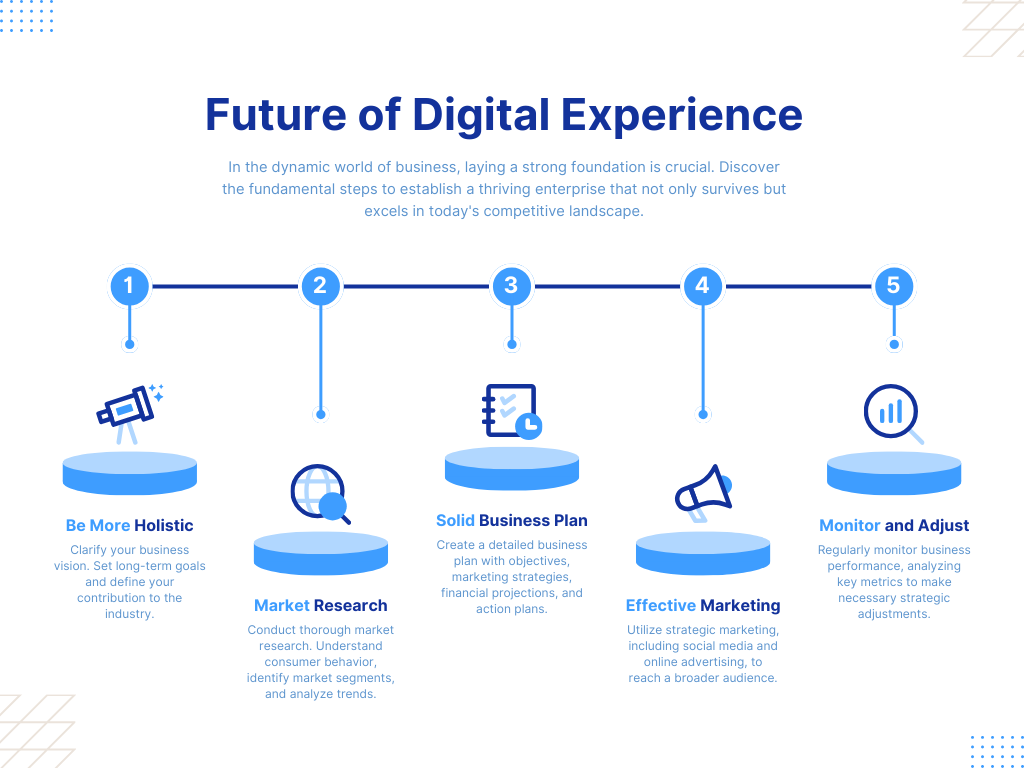Digital experience isn't just about having an online presence anymore. For today's enterprises, it's a critical business enabler-it impacts everything from operational efficiency to customer loyalty and brand differentiation. With the emphasis on advanced technologies, streamlined workflows, and reimagined customer engagement, digital experience is now firmly front and center in strategy discussions at the top.
For companies like Valuebound, the question isn't what's the latest tech to implement, but rather how to integrate humans and technology together to truly transform their business. Here's what every C-suite executive needs to know to stay ahead of the curve.

Making the Most of Digital Ecosystem Beyond UX
The concept of user experience in software development has come to evolve under new definitions. Traditionally, UX has been all about the design elements, but the future of the digital experience calls for something more holistic. It's not really about creating a robust digital ecosystem that connects users, data, and systems in the most harmonious manner to increase performance and adaptability.
This would require an agile approach to development, where systems can change in real time. Systems will be able to transform themselves in real-time based on the changing needs of not just its internal stakeholders but also for its customers. This is to say that the future digital experience would be about refinement where personalization and scalability more or less go hand-in-hand.
Force Multipliers for Organizations: AI and Automation
From theoretical to practical, the conversation on AI and automation changed. In software development, the technology is a significant augmenter of human capabilities and accelerates delivery timelines. For businesses, there's less about replacing the human with AI but about when AI is working together with human expertise as the betterment for decision making and productivity.
C-suite leaders ought to find a sense of how AI works into their overall digital strategy. As I see in my work with Valuebound, AI-driven tools are transforming the gamut-from ensuring the rightness of code to real-time application monitoring and incident resolutions. In organizations that demand fast scaling without compromising quality standards put in place, AI and automation act as force multipliers-that is, faster development cycles, higher precision, and greater user satisfaction.
Considering Intelligent Content Delivery with Hyper-Personalization
The scale at which a personalized experience needs to be delivered is no longer an option—it is an expectation. Long gone are the static websites and generic, text-based apps. Enterprise must now keep creating dynamic experiences that adapt in real time to the individual user behaviors and preferences.
Machine learning algorithms are reshaping hyper-personalization for content management. AI-driven enterprise platforms in the form of Drupal and WordPress make available the potential of adapting the content and interfaces based on user profiles in dynamic and real-time terms to organizations. The problems for IT companies here would be to create the systems that can handle huge amounts of data as well as facilitate contextually relevant and technically efficient personalized content delivery.
Personalization should not be just marketing but embedded into every interaction-from a product page or to an internal service portal. It is about building systems that learn and get better with each interaction, add value, and minimize friction.
Turning Data-Driven Experiences to Actionable Insights
If AI and automation serve as the engines of future digital experiences, then data is the fuel. Every interaction, every click, every session holds priceless possibilities for refinement and optimization of the experience. Raw data, however, has no intrinsic value until it can be used for action.
With C-level executives, it is to build a data infrastructure that will power digital platforms and support continuous feedback loops. Predictive analytics, for example, could predict the needs of customers, and advanced A/B testing could refine how content is delivered. Today, modern data systems are the need of the hour in companies competing to gain market share.
The final trend has to do with using real-time data to power predictive maintenance and operational efficiencies on SaaS platforms. Imagine an environment where backend systems predict outages or dips in performance before they happen-to allow for proactive interventions that could make for seamless user experiences. That's where enterprise-level data ecosystems are headed.
Hopping onto Holistic Approach with convergence of development and customer experience (CX)
In the past, software development and customer experience did operate in silos. Developers would build the systems, and the customer experience team was committed to handling the user interface. That is an archaic model. The future calls for an integrated model in which development teams and CX professionals work together to deliver cohesive digital experiences.
This is true particularly for companies like Valuebound, which necessarily integrate CX teams tightly with the teams engaged in DevOps. A product is no longer enough; it must change with every piece of feedback from the customer and interaction data. Development cycles must be iterative, with evolution in constant states, which is driven by real-world usage.
For the C-level executives, that would be a shift in mindset, one where digital experience is not an after-thought but becomes a core pillar of the product. The integration of these seemingly disparate domains will define the new wave of success for enterprises going forward.
Making Your DX Future-Proof with Agile, Scalable, Secure Approach
Future-proofing one's digital experience in a constantly disrupted world is extremely important. Agility and scalability have dominated software development for long, but security increasingly becomes a non-negotiable part of the digital ecosystem. On top of this, cyber threats are on the rise and regulatory landscapes are getting progressively more complicated, so good security posturing becomes a must for businesses to sustain trust with customers.
However, security at all costs cannot come at the cost of innovation. For instance, blockchain is such an advancement that enables companies to be integrated into secure as well as transparent structures while also enhancing the speed and efficiency of digital transactions. Microservices architecture also makes it possible for the business to deploy updates and features independent of each other so that the digital experience evolves, and high-level overhauls at a system level are avoided.
For IT service companies, systems that keep the future in view would be constantly built on a premise that is a constant balance between innovation and security, scalability, and evolution towards new compliance requirements.
Looking Ahead: Emerging Technologies & Their Unfolding Impact
With all this said about AI, data, and automation, there is still much more revolutionary tech in the pipeline: quantum computing, edge computing, to name just two. The next ten years promise to continue pouring technologies upon technologies that redefine what's possible for digital experiences.
For C-level executives, it is no longer just a matter of keeping up with the trends-it's developing organizational agility that allows your organization to move nimbly in response to new and emerging technologies. Proactive and not merely reactive, companies will be the pace-setters of the future in their industry.
Conclusion: Consider the Strategic Growth Imperative
In the digital saturation of today's world, the lines between business operations and digital experience are blurring. It's time for business leaders to recognize that digital experience is far from a marketing play-it's a strategic business imperative. Companies will only be able to unlock exciting customer experiences and growth if they can effectively blend human potential with technological progress.
More than a one-time tech upgrade, your business deserves. Here at Valuebound, we combine innovation with human expertise to help your organization lead the digital revolution. Are you ready to redefine the way of operation and serve customers? Contact our experts today for the first step towards sustainable digital innovation.
Frequently Asked Questions
Q1: How does AI enhance the enterprise's digital experience?
AI enhances the enterprise's digital experience by automating tasks, providing predictive insights, creating hyper-personalization, and improving speed and accuracy.
Q2: In what ways do data and experience contribute to better digital experiences?
Data allows the businesses to fine-tune digital interactions based on the behavior of the users, hence better and efficient experiences. It predicts customer needs in real time, enhancing performance.
Q3: Why is development and CX integration critical?
The development with customer experience integration is important because actual customer interaction takes products as evolving in real time. Therefore, this means real-time improvement of the product as well as the satisfaction of the users.
Q4: How are companies going to future-proof their digital ecosystems?
By embracing agile, scalable and secure technologies like microservices and blockchain, businesses would be able to ensure that their digital systems will be nimble enough and resilient against the impending disruptions.
Q5: What are the emerging technologies that will shape the future of digital experience?
Quantum computing, Edge computing, other advanced AI capabilities will drive the next wave of innovation in digital experiences, allowing them to stay nimble and use these advances.





